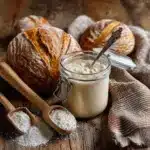Description
Create a traditional sourdough starter using simple ingredients and a natural fermentation process. This starter forms the base for delicious homemade sourdough bread, developing complex flavors and a bubbly, active culture over 7 to 8 days.
Ingredients
Scale
Starter Ingredients
- 1/4 cup unbleached all-purpose flour (plus additional for feedings)
- 1/2 cup water (preferably non-chlorinated fresh water, plus additional for feedings)
Instructions
- Day 1: Initial Mix. Combine 1/2 cup water and 1/4 cup unbleached all-purpose flour in a clean glass jar. Stir thoroughly until a thick, uniform mixture forms. This provides the base for your sourdough culture.
- Day 2: Rest. Allow the mixture to rest undisturbed to begin natural fermentation. No feeding or stirring is needed on this day.
- Day 3: First Feeding. Check for a dark liquid (hooch) on top, which is normal and indicates fermentation. Discard half of the starter mixture to manage growth and flavors. Add 1/2 cup flour and 1/4 cup water. Stir well to integrate all ingredients.
- Days 4-7: Daily Feedings. Each day, discard half of the starter to maintain balance. Then add 1/2 cup unbleached all-purpose flour and 1/4 cup water. Stir thoroughly to encourage active fermentation and development.
- Day 7-8: Assess Maturity. Your sourdough starter should now be bubbly, have doubled in size, and appear fluffy. If the starter hasn’t reached this stage, continue the daily feeding process until it does.
- Transfer Starter. When your starter is active and bubbly, transfer it to a fresh glass jar to keep it healthy and ready for baking.
Notes
- Use unbleached, all-purpose flour for best fermentation results.
- Non-chlorinated water is important as chlorine can inhibit fermentation.
- Discarded starter can be used in recipes like pancakes or waffles to minimize waste.
- Maintain consistent temperature around 70-75°F (21-24°C) for optimal fermentation.
- If your starter develops any pink or orange hues or foul odors, discard it and start over as this indicates contamination.
- Feedings can be adjusted slightly depending on starter activity and environment.
- Prep Time: 10 minutes initially; about 5 minutes each feeding
- Cook Time: 0 minutes (no cooking involved)
- Category: Bread Starter
- Method: Fermentation
- Cuisine: International
Nutrition
- Serving Size: 2 tablespoons (30g)
- Calories: 60
- Sugar: 0.1g
- Sodium: 1mg
- Fat: 0.2g
- Saturated Fat: 0.03g
- Unsaturated Fat: 0.15g
- Trans Fat: 0g
- Carbohydrates: 13g
- Fiber: 0.4g
- Protein: 2g
- Cholesterol: 0mg
Keywords: sourdough starter, bread starter, fermentation, natural yeast, homemade starter

